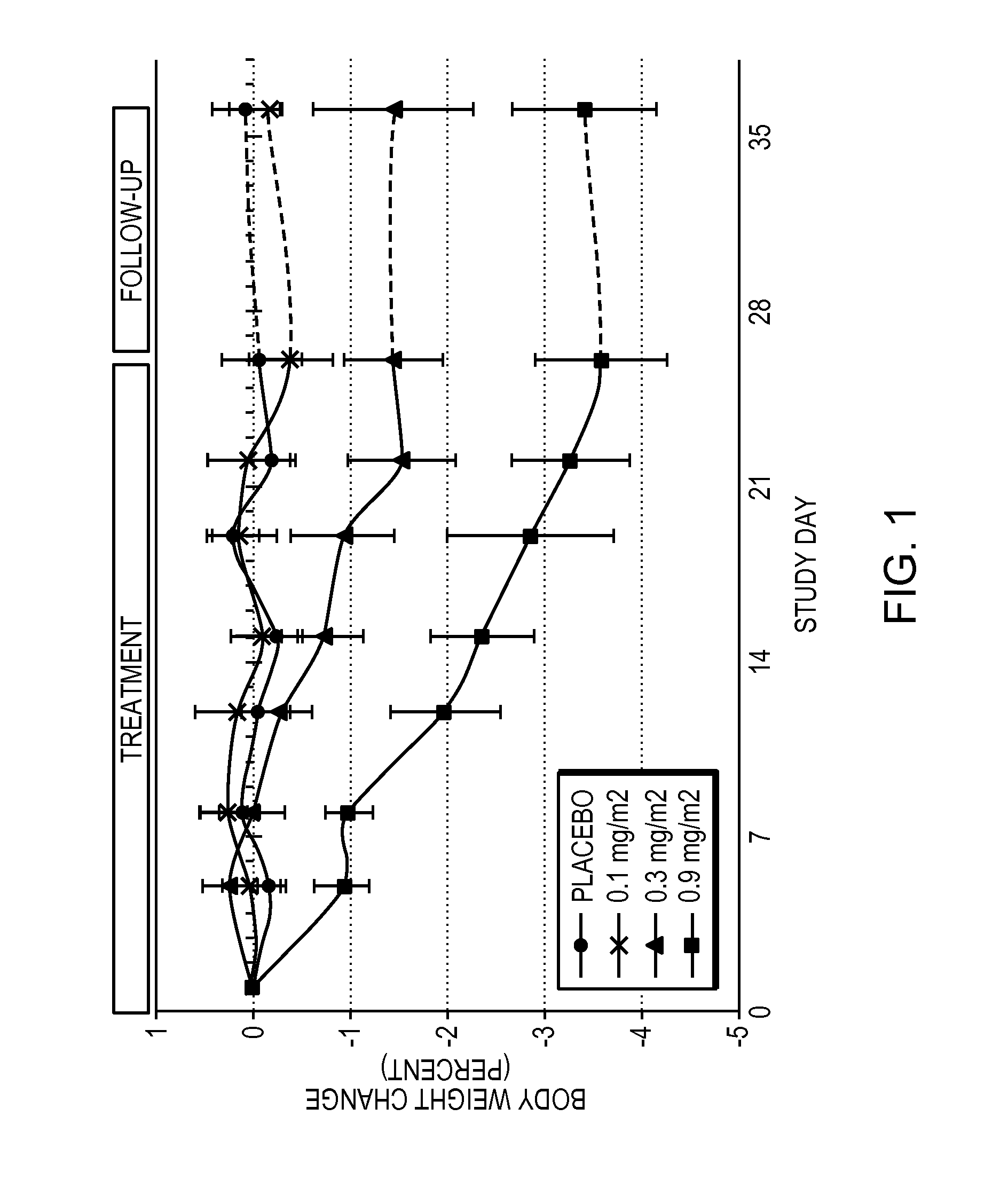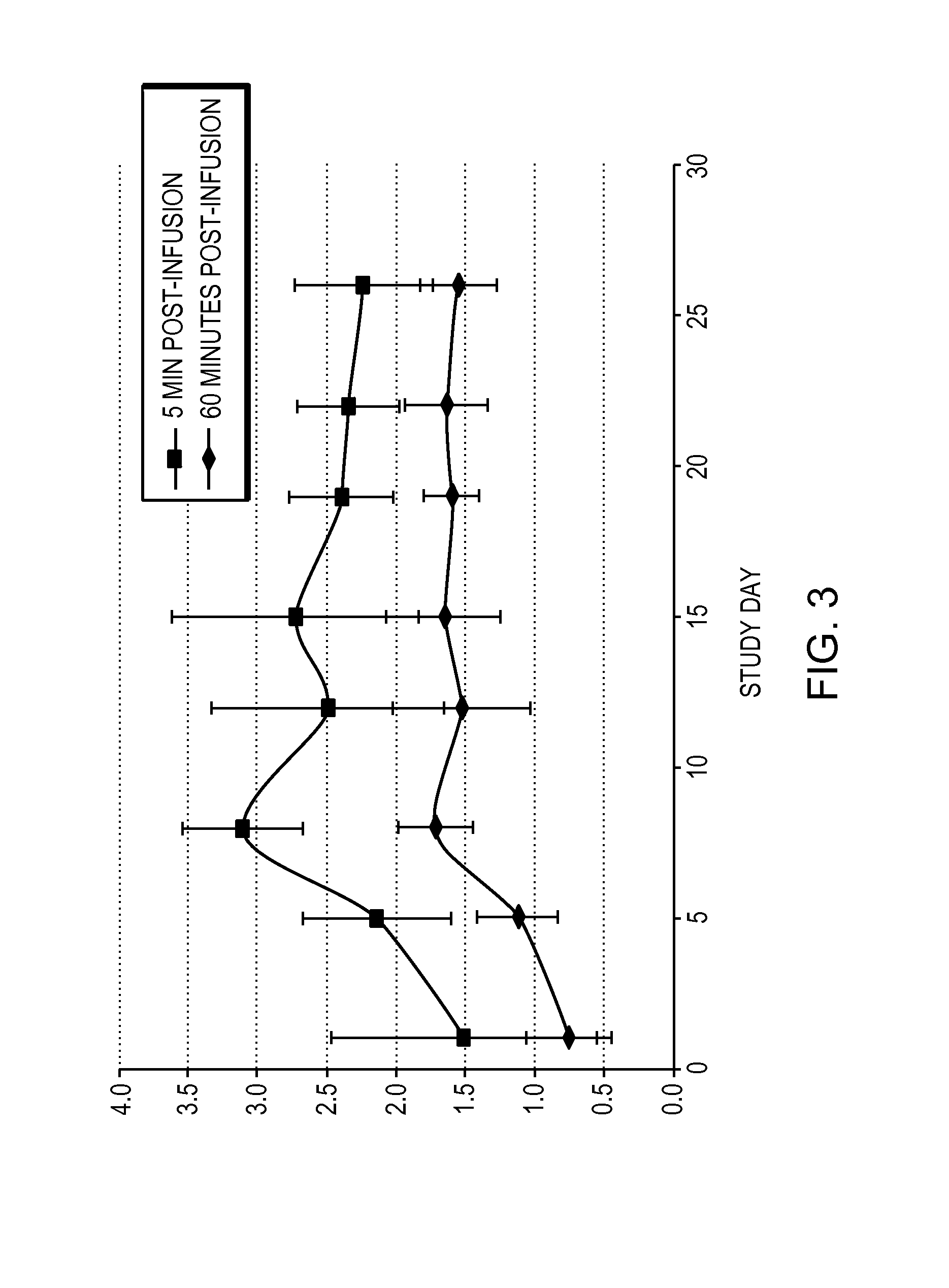Treatment of obesity using non-daily administration of 6-O-(4-dimethylaminoethoxy) cinnamoyl fumagillol
a technology of cinnamoyl fumagillol and cinnamoyl aminoethoxy, which is applied in the direction of drug composition, biocide, metabolic disorder, etc., can solve the problems of 3-5% reduction in body weight after a year of treatment, excessive accumulation of adipose tissue mass, and unsatisfactory efficacy of severely obese subjects
- Summary
- Abstract
- Description
- Claims
- Application Information
AI Technical Summary
Benefits of technology
Problems solved by technology
Method used
Image
Examples
example 1
Less than Weekly Administration of a MetAP2 Inhibitor to Obese Humans
[0061]Obese patients were treated in three cohorts with intravenous administration of a formulation of the compound 6-O-(4-dimethylaminoethoxy)cinnamoyl fumagillol oxalate. The compound was intravenously administered to each patient of a cohort (except for a placebo cohort) twice weekly for 26 days. Each of patients in the three non-placebo cohorts received either 0.1 mg / m2 (cohort 1); 0.3 mg / m2 (cohort 2); or 0.9 mg / m2 (cohort 3) doses of the compound at the time of administration. The trial was conducted under the appropriate government and medical supervision.
[0062]Weight reduction occurred for 4 days after single administration of 0.9 mg / m2 dose, despite terminal half life of the drug of only 5.4 hours (T1 / 2 (H) λz (terminal) is 5.41±2.82 in cohort 3), indicating daily administration is not needed. Table 1 summarizes body weight determination of the 9 patients in the 0.9 mg / m2 cohort on the day of the first dos...
example 2
Correlation of Effective Dose and Excess Body Weight
[0067]All of the subjects of the trial described in Example 1 received doses ranging from 1.8 to 2.2 mg with each administration (given twice weekly). However, weight change was not strictly associated with dose delivered. Instead, response was strongly associated with dose administered per unit excess body weight, as compared to weight change associated with dose delivered per unit body weight. FIG. 6 indicates the body weight change of patients in the combined 0.1 and 0.3 mg / m2 cohorts vs. dose of compound in μg per kg excess weight of patient, and indicates that exceeding approximately 40 μg of drug per kg of excess body weight may be important in order to see effects in obese patients.
[0068]This correlation may be due to obtaining the drug effect at least in part by exposure of the drug to adipose tissue. This indicates that dosing appropriately with a MetAP2 inhibitor surprisingly requires consideration of a patient's excess w...
example 3
Adiponectin Levels
[0070]Levels of adiponectin in the serum of patients undergoing the trial were also measured. Adiponectin concentrations were markedly increased (by over 60%, see FIG. 8) with treatment, also pointing to the importance of adipose as a target for the drug since adiponectin is produced by fat cells. FIG. 8 also indicates that there is a strong correlation between adiponectin changes and excess weight loss.
[0071]FIG. 9 indicates the changes in the ratio of two adipocyte factors (leptin and adiponectin) for subjects in the 0.3 and 0.9 mg / m2 cohorts after 26 days of the trial. The effect of treatment on the ratio of leptin to adiponectin appears to be a particularly strong predictor of weight. Combined, these observations appear to indicate that adipose tissue is a critical target related to weight loss, and that targeting fat tissue for MetAP2 inhibitors or dosing to achieve optimal fat tissue exposure is important.
PUM
| Property | Measurement | Unit |
|---|---|---|
| body weight loss | aaaaa | aaaaa |
| weight loss | aaaaa | aaaaa |
| time | aaaaa | aaaaa |
Abstract
Description
Claims
Application Information
 Login to View More
Login to View More - R&D
- Intellectual Property
- Life Sciences
- Materials
- Tech Scout
- Unparalleled Data Quality
- Higher Quality Content
- 60% Fewer Hallucinations
Browse by: Latest US Patents, China's latest patents, Technical Efficacy Thesaurus, Application Domain, Technology Topic, Popular Technical Reports.
© 2025 PatSnap. All rights reserved.Legal|Privacy policy|Modern Slavery Act Transparency Statement|Sitemap|About US| Contact US: help@patsnap.com



